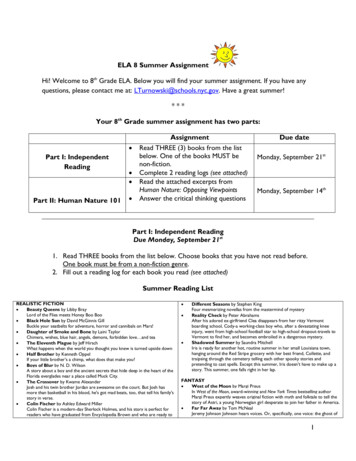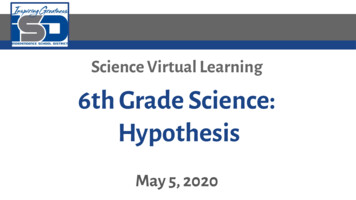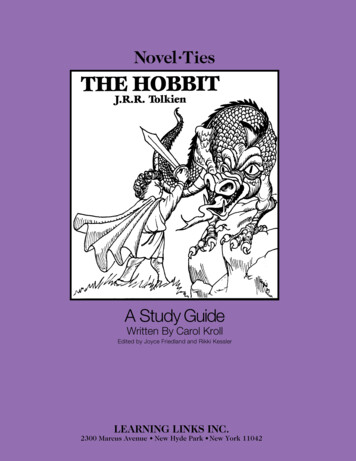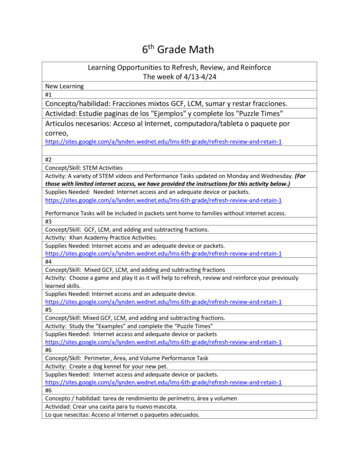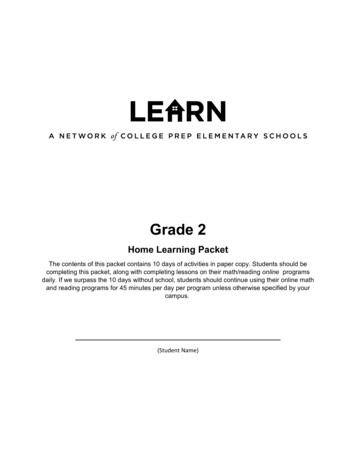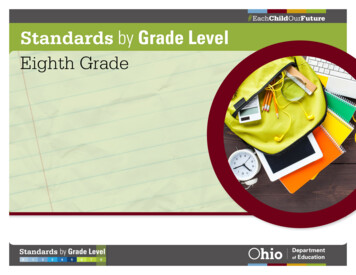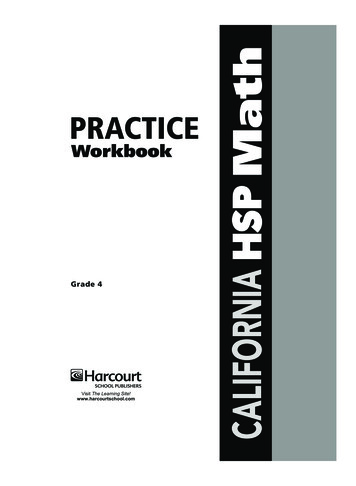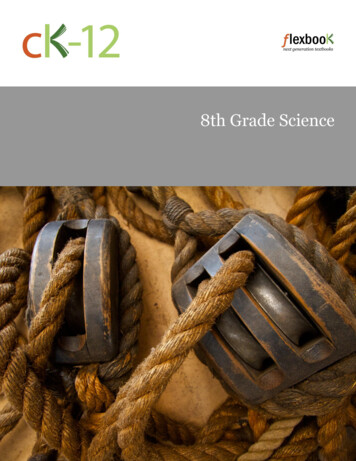
Transcription
8th Grade ScienceUtah OER DOESay Thanks to the AuthorsClick http://www.ck12.org/saythanks(No sign in required)
www.ck12.orgTo access a customizable version of this book, as well as otherinteractive content, visit www.ck12.orgAUTHORUtah OER DOECK-12 Foundation is a non-profit organization with a mission toreduce the cost of textbook materials for the K-12 market both inthe U.S. and worldwide. Using an open-source, collaborative, andweb-based compilation model, CK-12 pioneers and promotes thecreation and distribution of high-quality, adaptive online textbooksthat can be mixed, modified and printed (i.e., the FlexBook textbooks).Copyright 2016 CK-12 Foundation, www.ck12.orgThe names “CK-12” and “CK12” and associated logos and theterms “FlexBook ” and “FlexBook Platform ” (collectively“CK-12 Marks”) are trademarks and service marks of CK-12Foundation and are protected by federal, state, and internationallaws.Any form of reproduction of this book in any format or medium,in whole or in sections must include the referral attribution linkhttp://www.ck12.org/saythanks (placed in a visible location) inaddition to the following terms.Except as otherwise noted, all CK-12 Content (including CK-12Curriculum Material) is made available to Users in accordancewith the Creative Commons Attribution-Non-Commercial 3.0Unported (CC BY-NC 3.0) License (http://creativecommons.org/licenses/by-nc/3.0/), as amended and updated by Creative Commons from time to time (the “CC License”), which is incorporatedherein by this reference.Complete terms can be found at http://www.ck12.org/about/terms-of-use.Printed: June 28, 2016iii
Contentswww.ck12.orgContents12345ivStandard I: Matter1.1Does Matter? . . . . . . . . . . . . . . . . .1.2Is it possible to change your breath into food?1.3Chemical and Physical Changes . . . . . . .1.4Chemical Reactions . . . . . . . . . . . . . .1371318Standard II: Energy2.1How does the sun make you move?2.2Relationships . . . . . . . . . . .2.3Are You A Parasite? . . . . . . . .2.4References . . . . . . . . . . . . .2526303742Standard III: Earth3.1Rocks and Minerals . . . . . . . . . . . . . . . . . . . . . . . . . . .3.2The Rock Cycle . . . . . . . . . . . . . . . . . . . . . . . . . . . . .3.3Describe how rock and fossil evidence is used to infer Earth’s history?3.4Compare rapid and gradual changes to Earth’s surface . . . . . . . . .3.5References . . . . . . . . . . . . . . . . . . . . . . . . . . . . . . . .434452607176Standard IV: Motion4.1Does a Tsunami Carry Energy? . . . . . . . . . . . . . . . . . . . . . . . . .4.2Have you ever cooked over a campfire? . . . . . . . . . . . . . . . . . . . . .4.3Mass and Weight: What is the Difference? . . . . . . . . . . . . . . . . . . .4.4How Do Machines Make Work Easier? . . . . . . . . . . . . . . . . . . . . .4.5If a tree falls in a forest, and no one is around to hear it, does it make a sound?4.6How Do Organisms Sense Energy? . . . . . . . . . . . . . . . . . . . . . . .4.7References . . . . . . . . . . . . . . . . . . . . . . . . . . . . . . . . . . . .77. 78. 85. 90. 95. 104. 108. 110Glossary - 8th Grade.111
www.ck12.orgChapter 1. Standard I: MatterC HAPTER1Standard I: MatterChapter Outline1.1D OES M ATTER ?1.2I S IT POSSIBLE TO CHANGE YOUR BREATH INTO FOOD ?1.3C HEMICAL AND P HYSICAL C HANGES1.4C HEMICAL R EACTIONSWhy Science?Many students equate science to learning vocabulary terms, labeling pictures, and memorizing facts. Science bynature is much more inclusive and loosely defined. Have you ever asked yourself questions about your surroundingsand wondered how or why they are happening? This is science. Science works best when driven by curiosity andinnovation. In order for you to experience science in its fullest sense you must take it beyond the textbook and intoyour everyday experience, but in order to be meaningful there are certain guidelines that can help us. Science is notconstrained to 8th Grade Integrated Science, but there are crosscutting concepts threaded throughout all scientificdisciplines. These include: Patterns: The pattern of indicators used to determine if a chemical or physical change has taken place or thepattern of a wave’s wavelength in relation to the energy in the wave. Cause and effect: Mechanism and explanation: Cause and effect relationships are demonstrated when heatis added or removed from H2 O and changes in particle motion, density, temperature and states of matter areobserved. Scale, proportion, and quantity: Determining the proportions of a lever allows one to calculate its mechanicaladvantage. Systems and system models: Making models increases student understanding of chemical reactions, rollercoasters, the rock cycle and a food web. Energy and matter: Flows, cycles, and conservation: The conservation energy and matter is demonstrated ineach unit in eighth grade. Matter is conserved and energy flows in chemical and physical changes, the rockcycle, all forms of motion and through living systems. Potential and kinetic energy and the rock cycle arecyclical. Structure and function: The structure of a wave relates to how it can be absorbed, reflected or transmittedthrough different substances. The physical and chemical properties of a substance determine how they areused in everyday life. Stability and change: Changes in an ecosystem affect the stability of that environment and its ability to supportthe life forms in it.When studying any specific scientific discipline you should attempt to keep these crosscutting concepts in mind inorder to gain a better perspective of the world as whole and the nature of science. Included in the concepts are theskills and practices that a scientist utilizes. When asking questions about the natural world there are certain skillsand practices that can help you be generate better conclusions, explanations and inferences. These practices include: Asking questions and defining problemsDeveloping and using modelsPlanning and carrying out investigationsAnalyzing and interpreting data1
www.ck12.org Using mathematics and computational thinkingConstructing explanations and designing solutionsEngaging in argument from evidenceObtaining, evaluating, and communicating informationWhile these practices and crosscutting concepts are crucial to your overall success in science, in order to be mostmeaningful they do need some context. This is where the study of disciplinary core ideas are most impactful.If you study 8th Grade Integrated Science or any other scientific discipline without the cross cutting conceptsand scientific practices then you limit yourself to fact memorization and miss how these concepts relate to oureveryday life and our society as a whole. Studying individual scientific disciplines are the vehicle for understandingcrosscutting concepts and acquiring scientific skills. When individual disciplines are studied within the context ofpractices and crosscutting concepts they become more meaningful and more impactful.Standard 1: Students will understand the nature of changes in matter.Objective 1: Describe the chemical and physical properties of various substances.1. Differentiate between chemical and physical properties.2. Classify substances based on their chemical and physical properties (e.g., reacts with water, does not reactwith water, flammable or nonflammable, hard or soft, flexible or nonflexible, evaporates or melts at roomtemperature).3. Investigate and report on the chemical and physical properties of a particular substance.Objective 2: Observe and evaluate evidence of chemical and physical change.1. Identify observable evidence of a physical change (e.g., change in shape, size, phase).2. Identify observable evidence of a chemical change (e.g., color change, heat or light given off, change in odor,gas given off).3. Observe and describe chemical reactions involving atmospheric oxygen (e.g., rust, fire, respiration, photosynthesis).4. Investigate the effects of chemical change on physical properties of substances (e.g., cooking a raw egg, ironrusting, polymerization of a resin).Objective 3: Investigate and measure the effects of increasing or decreasing the amount of energy in a physical orchemical change, and relate the kind of energy added to the motion of the particles.1. Identify the kinds of energy (e.g., heat, light, sound) given off or taken in when a substance undergoes achemical or physical change.2. Relate the amount of energy added or taken away from a substance to the motion of molecules in the substance.3. Measure and graph the relationship between the states of water and changes in its temperature.4. Cite evidence showing that heat may be given off or taken in during a chemical change (e.g., striking a match,mixing vinegar and antacid, mixing ammonium chloride and water).5. Plan and conduct an experiment, and report the effect of adding or removing energy on the chemical andphysical changes.Objective 4: Identify the observable features of chemical reactions.1. Identify the reactants and products in a given chemical change and describe the presence of the same atoms inboth the reactants and products.2. Cite examples of common significant chemical reactions (e.g., photosynthesis, respiration, combustion, rusting) in daily life.2
www.ck12.orgChapter 1. Standard I: Matter3. Demonstrate that mass is conserved in a chemical reaction (e.g., mix two solutions that result in a color changeor formation of a precipitate and weigh the solutions before and after mixing).4. Experiment with variables affecting the relative rates of chemical changes (e.g., heating, cooling, stirring,crushing, concentration).Research and report on how scientists or engineers have applied principles of chemistry to an application encounteredin daily life (e.g., heat-resistant plastic handles on pans, rust-resistant paints on highway bridges).3
1.1. Does Matter?www.ck12.org1.1 Does Matter?Objectives Differentiate between chemical and physical properties. Classify substances based on their chemical and physical properties. Investigate and report on the chemical and physical properties of a particular substance.What is Matter?Both you and a speck of dust consist of atoms of matter - (anything that has atoms and takes up space). So doesthe ground beneath your feet. In fact, everything you can see, touch, taste, and smell is made of matter. Things thataren’t matter are forms of energy, such as light, heat, and sound. Although forms of energy are not matter, the airand other substances they travel through are. So what is matter?Matter is defined as anything that has mass - (amount of matter in an object) and volume - (amount of space takenup by an object).MassThe amount of mass in an object is commonly measured with a balance. A digital balance is shown in the figure.The Standard International (SI or metric) unit for mass is the kilogram (Kg), but for smaller masses grams (g) areoften used instead.FIGURE 1.1This balance shows one way of measuring mass.4
www.ck12.orgChapter 1. Standard I: MatterPhysical Properties of MatterMatter has many properties. Properties are characteristics that describe matter. Physical properties - (properties ofmatter that can be measured or observed without matter changing the substance) are typically things you can detectwith your senses. For example, whether a given substance normally exists as a solid, liquid, or gas is a physicalproperty. Consider water, it is a liquid at room temperature, but frozen water (ice) is still water. Generally, physicalproperties are things you can see, smell, taste, or feel.Examples of Physical PropertiesPhysical properties include the phase of matter, its color and odor. For example, oxygen is a colorless, odorlessgas. Chlorine is a greenish gas with a strong, sharp odor. The physical properties of oxygen gas are colorlessand odorless while the physical properties of chlorine gas are green and stinky. Other physical properties includehardness, freezing and boiling points, temperature, density, the ability to dissolve in other substances, and the abilityto conduct heat or electricity. Can you think of other physical properties?DensityDensity - (amount of mass in a given volume) is a physical property of matter. It is defined as a substance’s massper unit volume. It reflects how closely packed the particles of matter are. Density is calculated from the amount ofmass in a given volume of matter, using the formula:Density (D) Mass (M)Volume (V )Problem: What is the density of a substance that has a mass of 20 g and a volume of 10 mL?Solution: D 20 g10 mL 2.0 g/mLProblem: An object has a mass of 180 kg and a volume of 90 m3 . What is its density?Solution: D 180 kg90 m3 2.0 kg/m3You Try It!To better understand density, think about a bowling ball and a volleyball. The bowling ball feels heavy. It is solid allthe way through. It contains a lot of tightly packed particles of matter. In contrast, the volleyball feels light. It is fullof gasses. It contains fewer, more widely spaced particles of matter. Both balls have about the same volume, but thebowling ball has a much greater mass. Its matter is more dense.Chemical Properties of MatterSome properties of matter can be measured or observed only when matter undergoes a change to become an entirelydifferent substance. These properties are called chemical properties - (properties that describe the ability of asubstance to undergo a specific chemical change) they include flammability - (ability to ignite) and reactivity- (ability to participate in a chemical reaction).5
1.1. Does Matter?www.ck12.orgFIGURE 1.2Density is not the only physical property ofmatter. Here are some additional physicalproperties.FlammabilityFlammability is the ability of matter to ignite. Wood is flammable. When wood burns, it changes to ashes, carbondioxide, water vapor, and other gases. After burning, it is no longer wood.ReactivityReactivity is the ability of substances to undergo chemical reactions and release or absorb energy either by reactingwith themselves or with other materials. For example, iron is highly reactive with oxygen. When it combines withoxygen, it forms the reddish powder called rust. Rust is not iron but an entirely different substance, iron oxide, thatconsists of both iron and oxygen.Summary Matter is anything that has mass and volume. Mass is the amount of matter in a substance. Volume is theamount of space matter takes up. Matter has both physical and chemical properties. Physical properties can be measured or observed withoutmatter changing to a different substance. Chemical properties of matter can be measured or observed only when matter undergoes a change to becomean entirely different substance.6
www.ck12.orgChapter 1. Standard I: MatterFIGURE 1.3The iron in this steel chain has started to rust.Think like a ChemistRecall1. What is matter?2. Label each property as either Physical (P) or Chemical yOdorFreezing pointApply Concepts3. Create a table listing two physical and two chemical properties of iron.TABLE 1.1:PhysicalChemical4. Using your knowledge of salt dissolving in water, explain why the ability to dissolve is a physical propertyand not a chemical property?Think Critically5. Some kinds of matter are attracted to a magnet. Is this a physical or chemical property of matter? How do youknow?7
1.2. Is it possible to change your breath into food?www.ck12.org1.2 Is it possible to change your breath intofood?FIGURE 1.4When glass breaks, its physical properties change. Instead of one solidsheet of glass, it now has holes and cracks.Objectives Define and give examples of physical changes in matter.Define and give examples of chemical changes in matter.State five evidences that a chemical change has taken place.List two examples of a chemical change that requires atmospheric oxygen.IntroductionYou hit a baseball out of the park and head for first base. You’re excited. The score is tied, and now your team has achance of getting a winning home run. Then you hear a crash. Oh no! The baseball hit a window in a neighboringhouse. The glass has a big hole in it, surrounded by a web of cracks (see Figure 1.4). The glass has changed. It’sbeen broken into jagged pieces. But the glass is still glass. Breaking the window is an example of a physical changein matter.Physical Changes in MatterA physical change - (change in one or more physical properties of matter without any change in chemical properties)does not change the identity of the original substance. Glass breaking is just one example of a physical change.Some other examples are shown in the graphic and in this video: http://bit.ly/MG5zBHMEDIAClick image to the left or use the URL below.URL: 745In each example, matter may look different after the change occurs, but it’s still the same substance with the samechemical properties. For example, smaller pieces of wood have the ability to burn just as larger logs do.Because the type of matter remains the same with physical changes, the changes are often easy to undo. For example,braided hair can be unbraided. Melted chocolate can be put in a fridge to re-harden. Dissolving salt in water canprecipitate out of solution.8
www.ck12.orgChapter 1. Standard I: MatterFIGURE 1.5In each of these changes, only the physical properties of matter change.Thechemical properties remain the same.Q: How do you think you could reverse salt dissolving in water?Occasionally a physical change cannot be undone. An example would be grinding a piece of wood into sawdust.Such a change is irreversible because the sawdust cannot be reformed into the same piece of wood that it was before.Cutting the grass or pulverizing a rock are other examples of physical changes that cannot be reversed.Chemical Changes in MatterCommunities often use fireworks to celebrate important occasions. Fireworks certainly create awesome sights andsounds! Do you know what causes the brilliant lights and loud booms of a fireworks display? The answer is chemicalchanges.What is a Chemical Change?A chemical change - (matter changes into an entirely new substance with different properties) is also called achemical reaction. Many complex chemical changes occur to produce the explosions of fireworks.9
1.2. Is it possible to change your breath into food?www.ck12.orgAn example of a simpler chemical change is the burning of methane. Methane is the main component of naturalgas, which is burned in many home furnaces. During burning, methane combines with oxygen in the air to produceentirely different chemical substances, including the gases carbon dioxide and water vapor. You can watch somevery colorful chemical changes occurring in the video at this URL: https://www.youtube.com/watch?v BqeWpywDuiYMEDIAClick image to the left or use the URL below.URL: 612Identifying Chemical ChangesMost chemical changes are not as dramatic as exploding fireworks, so how can you tell whether a chemical changehas occurred? There are usually clues. You just need to know what to look for. A chemical change has probablyoccurred if bubbles are released, there is a change of color, or an odor is produced. Other clues include the releaseof heat, light, or sound. Examples of chemical changes that produce these clues are shown in the graphic.Q: How can you tell whether a chemical change has occurred?Often, there are clues. Several are demonstrated in the video below. http://bit.ly/1fsJ6RSMEDIAClick image to the left or use the URL below.URL: 849Physical Properties Change Due to Chemical ChangesWhen a chemical change takes place bonds are broken and atoms are rearranged creating new substances. The newsubstance will have new physical properties that are unique to that substance.10
www.ck12.orgChapter 1. Standard I: MatterChemical Reactions Involving Atmospheric OxygenDon’t try this at home! This performer isn’t really eating fire, but he still puts on an impressive show. You knowthat fire is dangerous. It’s hot, it can burn you, and it can easily get out of control. But do you know what fire is?Fire is the result of a chemical reaction. Whenever something burns, a type of reaction called a combustion reactionoccurs.What is a Combustion Reaction?A combustion reaction occurs when a substance reacts quickly with oxygen (O2 ). For example, in the Figure1.6, charcoal is combining with oxygen. Combustion is commonly called burning, and the substance that burns isusually referred to as fuel. The products of a complete combustion reaction include carbon dioxide (CO2 ) and watervapor (H2 O). This reaction typically gives off heat and light as well.FIGURE 1.6The burning of charcoal is a combustion reaction.Another combustion reaction involves magnesium. Watch as it reacts with oxygen to form magnesium oxide as seenin this video: http://bit.ly/1cDVy1lMEDIAClick image to the left or use the URL below.URL: 85111
1.2. Is it possible to change your breath into food?www.ck12.orgAnother type of reaction that requires atmospheric oxygen is known as an oxidation reaction. When exposed tooxygen in the air an object made of iron will eventually begin to rust.FIGURE 1.7Rust (iron oxide) forms on an unprotected iron surface.As the rust forms on the surface of the iron, it flakes off to expose more iron, which will continue to rust. Rust(Fe2 O3 ) is clearly a substance that is different from iron (Fe). Rusting is an example of a chemical change thatrequires atmospheric oxygen; this is known as corrosion. Corrosion is the gradual deterioration of materials, (usuallymetals), by chemical reactions within the environment.Reversing Chemical ChangesBecause chemical changes produce new substances, sometimes they cannot be easily undone. For example, youcan’t change a fried egg back to a raw egg. Some chemical changes can be reversed, but only by other chemicalchanges. For example, to undo the tarnish on copper pennies, you can place them in vinegar. The acid in the vinegarreacts with the tarnish. This is a chemical change that makes the pennies bright and shiny again. You can try thisyourself at home to see how well it works or check out the video at this URL: http://bit.ly/1fuo7ieMEDIAClick image to the left or use the URL below.URL: 853Summary Physical changes are changes in the physical properties of matter but not in the makeup of matter. An exampleof a physical change is glass breaking. Chemical changes are changes in the arrangement of the atoms in matter; they create a new substance. Theyare the result of a chemical reactions and cause a change in physical properties as well. Some chemicalchanges require oxygen to take place. Examples of these are rusting of metal or wood burning. A chemical change cannot be undone unless another chemical reaction takes place.Think like a Chemist1. How is a physical change in matter different from a chemical change?2. List five signs that indicate a chemical change has occurred.12
www.ck12.orgChapter 1. Standard I: MatterApply Concepts3. Butter melts when you heat it in a pan on the stove. Is this a chemical change or a physical change? How canyou tell?4. Eggs change when you heat them in a pan on the stove. Is this a chemical change or a physical change? Howcan you tell?Online Interactive Activities Play with fire! This interactive explores the chemical reactions involved in combustion. http://tinyurl.com/UT8th1-2a Practice identifying physical and chemical changes. http://tinyurl.com/UT8th1-2b13
1.3. Chemical and Physical Changeswww.ck12.org1.3 Chemical and Physical ChangesObjectives Identify the kinds of energy given off or taken in when a substance undergoes a chemical or physical change.Relate the amount of energy added or taken away from a substance to the motion of molecules in the substance.Measure and graph the relationship between the states of water and changes in its temperature.Cite evidence showing that heat may be given off or taken in during a chemical change. Plan and conduct anexperiment, and report the effect of adding or removing energy on the chemical and physical changes.IntroductionMatter is always changing state. Look at the two pictures of Mount Rushmore in Figure below. The picture on theleft was taken on a sunny summer morning. In this picture, the sky is perfectly clear. The picture on the right wastaken just a few hours later. In this picture, there are clouds in the sky. The clouds consist of tiny droplets of liquidwater.Q: Where did the water come from?How does the amount of energy determine the phase of matter?These neat rows of cola bottles represent matter in three different phases—solid, liquid, and gas. The bottles andcaps are solids, the cola is a liquid, and carbon dioxide dissolved in the cola is a gas. Solids, liquids, and gases suchas these have different properties. Solids have a fixed shape and a fixed volume. Liquids also have a fixed volume but can change their shape. Gases have neither a fixed shape nor a fixed volume.14
www.ck12.orgChapter 1. Standard I: MatterQ: What explains these differences in phases of matter? Hint: The answer has to do with energy.Moving MatterEnergy is the ability to move matter or change matter in some other way. For example, your body uses chemicalenergy when you lift your arm or take a step. In both cases, energy is used to move matter—you. The energy ofmoving matter is called kinetic energy. The particles of matter are in constant motion therefore the particles havekinetic energy. The theory that all matter consists of constantly moving particles is called the kinetic theory ofmatter. You can learn more about the theory at this URL: http://bit.ly/1aNHL9KMEDIAClick image to the left or use the URL below.URL: 855Kinetic EnergyDifferences in kinetic energy explain why matter exists in different states. Particles of matter are attracted to eachother, so they tend to pull together. The particles can move apart only if they have enough kinetic energy to overcomethis force of attraction. It’s like a tug of war between opposing sides, with the force of attraction between particleson one side and the kinetic energy of individual particles on the other side. The outcome of the “war” determinesthe phase of matter. Matter exists as a solid if particles do not have enough kinetic energy to overcome the force of attractionbetween them. The particles are packed closely together and held rigidly in place. All they can do is vibrate.This explains why solids have a fixed volume and a fixed shape. Matter exists as a liquid if particles have enough kinetic energy to partly overcome the force of attractionbetween them. The particles can slide past one another but not pull apart completely. This explains whyliquids can change shape but have a fixed volume. Matter exists as a gas if particles have enough kinetic energy to completely overcome the force of attractionbetween them. The particles can pull apart and spread out. This explains why gases have neither a fixedvolume nor a fixed shape.Look at the figure below. It shows the relationship between kinetic energy and phase of matter. You can see ananimated diagram at this URL: http://bit.ly/1eeA50U15
1.3. Chemical and Physical Changeswww.ck12.orgWhat are phase changes?Phase changes are physical changes in matter. They are reversible changes that do not involve changes in the chemical makeup or chemical properties of matter. Common phase changes include melting, freezing and evaporation.Energy, temperature and phase changesEnergy is always involved in changes of phase. Matter either loses or absorbs energy when it changes from onephase to another. For example, when matter changes from a liquid to a solid, it loses energy to its surroundings. Theopposite happens when matter changes from a solid to a liquid. For a solid to change to a liquid, matter must absorbenergy from its surroundings.When energy is added to water, its temperature increases. . . .unless it is changing phase. Look at the graph that showsthe relationship between temperature and phase of water as energy is added. Notice that when energy is added tosolid water (ice) the temperature rises until the ice reaches its melting point. While the ice is melting the temperaturestays the same. Once the ice has melted and the water is liquid then the temperature rises again until the liquid waterboils. Once again, the temperature stays the same until the liquid water has evaporated and become water vapor(stream). When all the liquid water has changed phase and become a gas (water vapor) then the temperature risesagain. The temperature does not change until the phase change is complete. The temperature does not change whilea phase change is happening because the energy is involved in the forces of attraction between molecules rather thanthe kinetic energy of the molecules.The amount of energy in matter can be measured with a thermometer. That is because a thermometer measurestemperature, and temperature is a measure of the average kinetic energy of the particles of matter in a substance.Changes between Liquids and SolidsThink about how you would make ice. First you would fill the tray with water, then you would place the tray in afreezer. The freezer has a very low temperature.16
www.ck12.orgChapter 1. Standard I: MatterFIG
3.Investigate and report on the chemical and physical properties of a particular substance. Objective 2: Observe and evaluate evidence of chemical and physical change. 1.Identify observable evidence o



